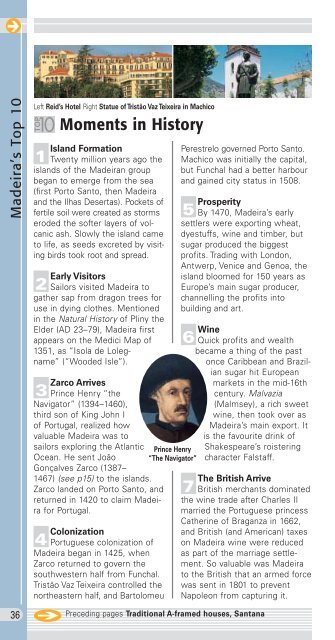Top 10 Madeira (Eyewitness Top 10 Travel Guides)
Top 10 Madeira (Eyewitness Top 10 Travel Guides)
Top 10 Madeira (Eyewitness Top 10 Travel Guides)
Create successful ePaper yourself
Turn your PDF publications into a flip-book with our unique Google optimized e-Paper software.
<strong>Madeira</strong>’s <strong>Top</strong> <strong>10</strong><br />
36<br />
Left Reid’s Hotel Right Statue of Tristão Vaz Teixeira in Machico<br />
Moments in History<br />
! Island Formation<br />
Twenty million years ago the<br />
islands of the <strong>Madeira</strong>n group<br />
began to emerge from the sea<br />
(first Porto Santo, then <strong>Madeira</strong><br />
and the Ilhas Desertas). Pockets of<br />
fertile soil were created as storms<br />
eroded the softer layers of volcanic<br />
ash. Slowly the island came<br />
to life, as seeds excreted by visiting<br />
birds took root and spread.<br />
Early Visitors @ Sailors visited <strong>Madeira</strong> to<br />
gather sap from dragon trees for<br />
use in dying clothes. Mentioned<br />
in the Natural History of Pliny the<br />
Elder (AD 23–79), <strong>Madeira</strong> first<br />
appears on the Medici Map of<br />
1351, as “Isola de Lolegname”<br />
(“Wooded Isle”).<br />
£ Zarco Arrives<br />
Prince Henry “the<br />
Navigator” (1394–1460),<br />
third son of King John I<br />
of Portugal, realized how<br />
valuable <strong>Madeira</strong> was to<br />
sailors exploring the Atlantic<br />
Ocean. He sent João<br />
Gonçalves Zarco (1387–<br />
1467) (see p15) to the islands.<br />
Zarco landed on Porto Santo, and<br />
returned in 1420 to claim <strong>Madeira</strong><br />
for Portugal.<br />
$ Colonization<br />
Portuguese colonization of<br />
<strong>Madeira</strong> began in 1425, when<br />
Zarco returned to govern the<br />
southwestern half from Funchal.<br />
Tristão Vaz Teixeira controlled the<br />
northeastern half, and Bartolomeu<br />
Prince Henry<br />
“The Navigator”<br />
Perestrelo governed Porto Santo.<br />
Machico was initially the capital,<br />
but Funchal had a better harbour<br />
and gained city status in 1508.<br />
% Prosperity<br />
By 1470, <strong>Madeira</strong>’s early<br />
settlers were exporting wheat,<br />
dyestuffs, wine and timber, but<br />
sugar produced the biggest<br />
profits. Trading with London,<br />
Antwerp, Venice and Genoa, the<br />
island bloomed for 150 years as<br />
Europe’s main sugar producer,<br />
channelling the profits into<br />
building and art.<br />
^ Wine<br />
Quick profits and wealth<br />
became a thing of the past<br />
once Caribbean and Brazilian<br />
sugar hit European<br />
markets in the mid-16th<br />
century. Malvazia<br />
(Malmsey), a rich sweet<br />
wine, then took over as<br />
<strong>Madeira</strong>’s main export. It<br />
is the favourite drink of<br />
Shakespeare’s roistering<br />
character Falstaff.<br />
The British Arrive & British merchants dominated<br />
the wine trade after Charles II<br />
married the Portuguese princess<br />
Catherine of Braganza in 1662,<br />
and British (and American) taxes<br />
on <strong>Madeira</strong> wine were reduced<br />
as part of the marriage settlement.<br />
So valuable was <strong>Madeira</strong><br />
to the British that an armed force<br />
was sent in 1801 to prevent<br />
Napoleon from capturing it.<br />
Preceding pages Traditional A-framed houses, Santana


